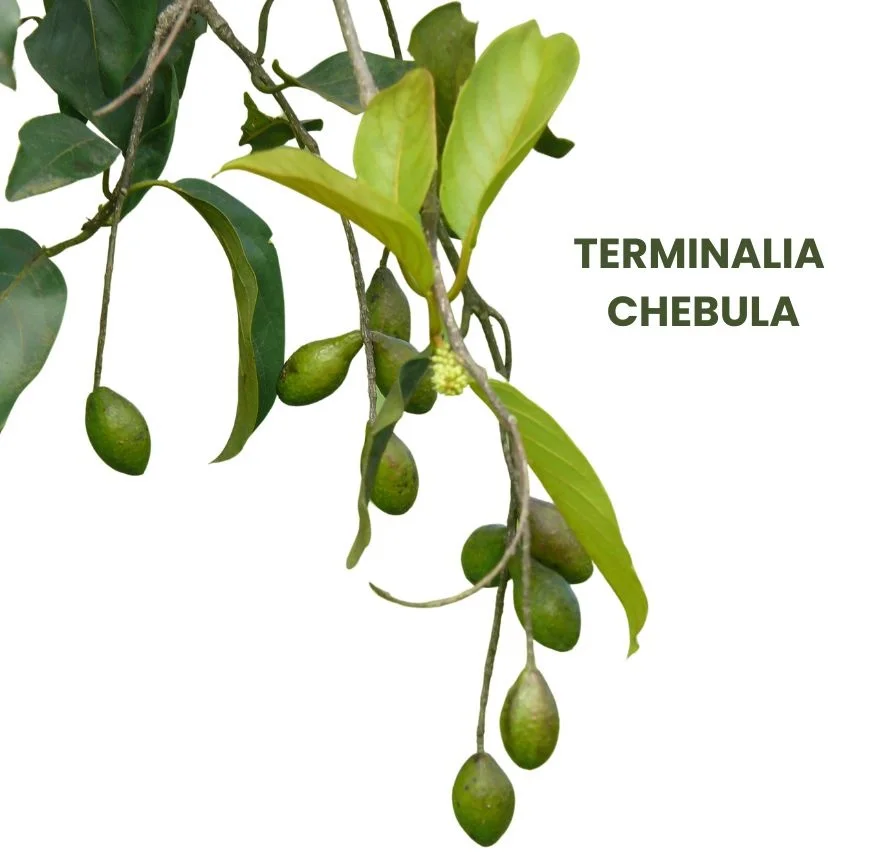Terminalia chebula, commonly known as Haritaki, is a significant medicinal plant in Ayurveda, belonging to the Combretaceae family.
Dr. B. Dutta was the first to prove its medicinal properties. It is traditionally used for a variety of ailments including digestive issues, bleeding piles, and some skin diseases.

Table of Contents
ToggleSOURCE INFORMATION
Common Names: Abhaya, Pathya, Har, Harara, Harrar, Hirda, Harda, Kadakai, Kadut-key (tree), Kadut-kaypinji (fruit), Karaka, Kurka (tree).
Scientific Classification
- Kingdom: Plantae
- Clade: Angiosperms
- Clade: Eudicots
- Order: Myrtales
- Family: Combretaceae
- Genus: Terminalia
- Species: T. chebula
Origin and Historical Facts
- Native Region: Terminalia chebula is native to South Asia, particularly India and Nepal.
- Historical Usage: Haritaki has been used in traditional Ayurvedic medicine for centuries.
- It is known for its ability to balance the doshas (body energies) and is considered one of the three key ingredients in the Ayurvedic formulation “Triphala.”
- Historically, it has been used to treat a variety of conditions such as digestive disorders, respiratory diseases, and infections.
Active Constituents
Terminalia chebula contains several bioactive compounds, including:
- Tannins: Provide astringent properties.
- Flavonoids: Offer antioxidant benefits.
- Glycosides: Contribute to its therapeutic effects.
- Chebulinic Acid: Has anti-inflammatory properties.
KEY CHARACTERISTICS
- Laxative: Promotes bowel movements.
- Digestive: Aids in digestion and alleviates gastrointestinal issues.
- Anti-inflammatory: Reduces inflammation.
- Astringent: Tightens tissues and reduces secretions.
DETAILED ORGAN SYMPTOMS
MIND
- Indifferent: A feeling of indifference and lack of interest in activities.
- Yawning: Constant yawning and a tendency to easily become indisposed.
HEAD
- Vertigo: Persistent dizziness, aggravated by exposure to hot sun, motion, and hard pressure. Improved by cold bathing, evening time, dry cold air, sleep, and eating.
MOUTH
- Salivation: Excessive saliva production with intense thirst for cold water.
- Dryness: Sensation of dryness in the upper jaw.
- Gums: Swollen and hard gums.
- Breath: Foul breath with fetid eructation.
TONGUE
- Appearance: Flabby, dry, with a brown coating on the tip. Sore and raw.
STOMACH
- Fullness: A constant sensation of fullness in the stomach.
PAIN
- Loin Pain: Intense pain in the loin, aggravated by sitting and relieved by lying down or sleeping.
- Neck Pain: Pain in the back of the neck.
- Chest Pain: Pressive pain in the right chest or heart area.
STOOL
- Desire: Frequent desire for stool with little or no output, accompanied by sweating during the process.
- Pain: Pressive pain with itching and a sensation of fullness in the rectum.
- Diarrhea: Small quantity of feces mixed with mucus.
- Flatulence: Associated with burning in the stomach.
- Constipation: Hard, small stool.
URINE
- Scanty: Reduced urine output.
- Frequency: Increased frequency of urination at night.
EXTREMITIES
- Muscular Pain: Pain in the deltoid muscles.
- Itching: Relieved by scratching.
PULSE
- Characteristics: Quick, irregular, hard, or weak at times.
RESPIRATION
- Breathing: Hot, deep breathing.
MODALITIES
- Aggravation: Symptoms worsen with hot sun’s rays, motion, and hard pressure.
- Amelioration: Symptoms improve with cold bathing, in the evening, dry cold air, sleep, and eating.
WHAT ARE MODALITIES IN HOMOEOPATHY?
DOSE
- Mother Tincture: Effective for general and acute symptoms.
- Potency: Recommended potencies include 3x, 6x, and 30 for chronic conditions and specific symptoms.
Frequently Asked Questions
What is Terminalia chebula used for?
- Terminalia chebula is used for treating a variety of conditions such as digestive issues, bleeding piles, chronic dysentery, constipation, colic, headaches, vertigo, dropsy, and some skin diseases.
How does Terminalia chebula help with gastrointestinal issues?
- The plant’s tannins and glycosides provide astringent and digestive benefits, which help alleviate gastrointestinal discomfort, promote bowel movements, and reduce inflammation.
Can Terminalia chebula be used for respiratory issues?
- Yes, it is known to have therapeutic effects on respiratory conditions, particularly those involving inflammation and infection.
What is the recommended dosage for chronic conditions?
- For chronic conditions, potencies of 3x, 6x, and 30 are recommended, depending on the severity and specific symptoms.
Glossary of Difficult Words
- Laxative: A substance that promotes bowel movements.
- Astringent: A substance that tightens tissues and reduces secretions.
- Vertigo: A sensation of dizziness.
- Pressive Pain: Pain that feels like pressure is being applied.
- Flatulence: Excessive gas in the digestive system.
- Scanty: Insufficient in quantity.
This detailed source information provides a comprehensive overview of Terminalia chebula, its medicinal properties, and therapeutic applications.
If you have any further questions or need additional information, feel free to ask!
